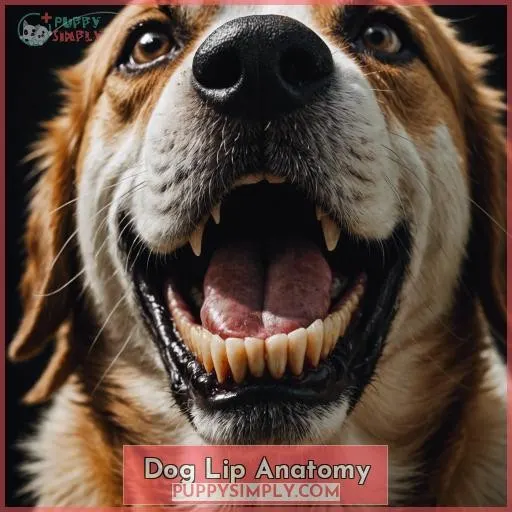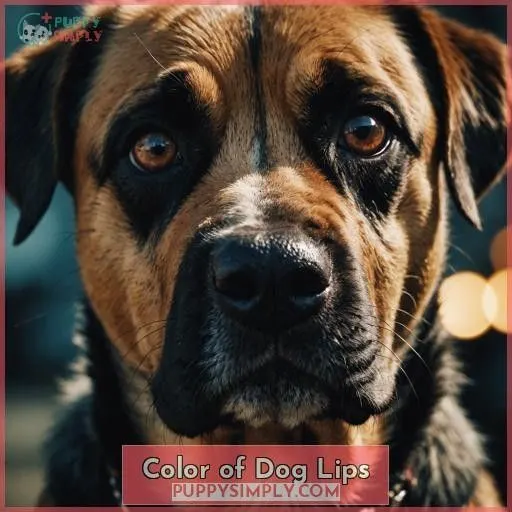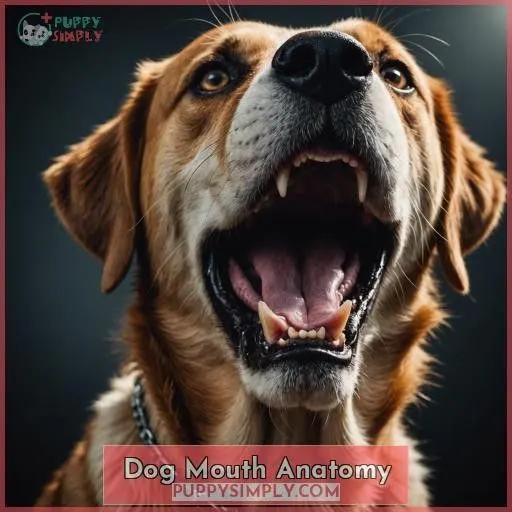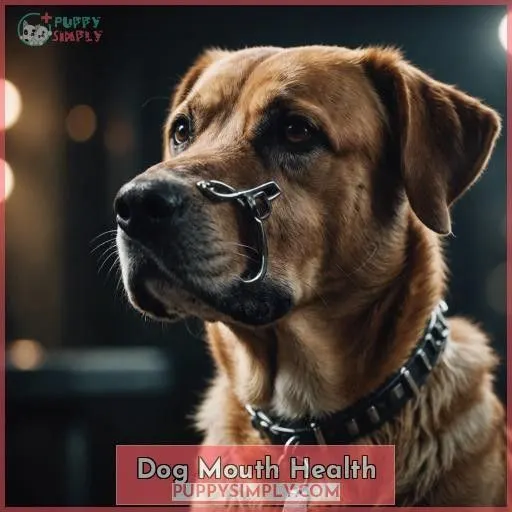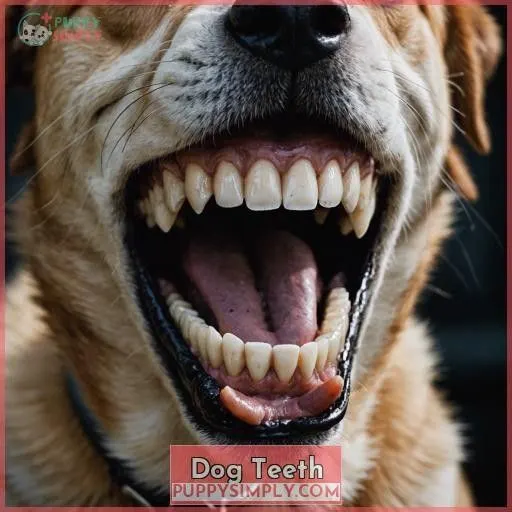This site is supported by our readers. We may earn a commission, at no cost to you, if you purchase through links.

Unique to each breed, the upper lips, known as flews, vary in size and appearance. On their lips, you’ll find tiny bumps called rugae, which help grip food for easy manipulation and create suction when drinking.
The lower lip is typically concealed by the upper lip’s flews.
Learn more about the fascinating anatomy of dog lips, their color variations, and their role in expressing emotions by continuing your exploration.
Table Of Contents
Key Takeaways
- Dogs have lips composed of rigid muscle tissue and skin folds, forming a continuous circle around their mouths.
- Unique to each breed, the upper lips (flews) vary in size and appearance.
- Tiny bumps called rugae on their lips aid in gripping food and creating suction for drinking.
- The lower lip is typically concealed by the upper lip’s flews.
Do Dogs Have Lips?
Yes, dogs have lips! Their lips are made up of skin, muscle, and mucous membrane, and they help to protect their teeth and gums.
Dog Lip Anatomy
Dogs have lips that form a continuous circle around their mouths. Their upper lips, called flews, vary in size and appearance depending on the breed. The lower lip is obscured by the flews.
Unlike humans, dogs have less cheek capacity. Their lips are composed of rigid muscle tissue and folds of skin surrounding the mouth, connected to the gums.
The lips’ texture is firm and slightly bumpy due to the presence of ruga, or rugal folds, which help grip and manipulate food and create suction for drinking liquids.
The lip musculature allows for a wide range of movements, aiding in food intake, temperature regulation, scent detection, and communication.
Bumps on Dog Lips
Notice those tiny bumps, or rugae, on your dog’s lips? They’re not just there for decoration! These lip wrinkles help your furry friend grip and manipulate food, create suction for drinking, and add an extra layer of protection for their gums.
But don’t worry, these lip folds are perfectly normal! Just like your own lips, your dog’s lips require a bit of TLC. Keep them clean and moisturized to prevent lip disease or oral papillomas.
Color of Dog Lips
The color of your dog’s lips can vary greatly depending on their genetics and breed. Darker lips are more common in dogs with high levels of melanin, a pigment that provides sun protection. This can be beneficial for dogs living in sunny climates, as it helps protect their lips from damage. However, some breeds have pink or light-colored lips due to genetic traits. Lip discoloration can also be a sign of certain health conditions, such as lip fold dermatitis or chapped lips. It’s important to consult with your veterinarian if you notice any changes in the color or texture of your dog’s lips.
| Lip Color | Cause |
|---|---|
| Dark | High melanin levels |
| Pink or light | Genetic traits |
| Discoloration | Health conditions |
Can Dogs Smile?
Dogs do things to express joy and contentment, like making a relaxed open mouth, raising their eyebrows, and tilting their head. Some dogs pull back their lips slightly, which looks like a smile. But this isn’t intentional smiling like humans do. Dogs’ facial expressions are primarily for communicating their mood and body language.
Dog Mouth Anatomy
Dogs’ mouths are captivating! Unlike humans, dogs possess uninterrupted lips that encompass their mouths. Their upper lips, known as flews, exhibit variations in size and appearance across different breeds. Their lower lips tend to be concealed by the flews.
Dogs have a reduced capacity in their cheeks compared to humans. The form and dimensions of their lips serve a critical function in retaining food, regulating body temperature, and safeguarding their mouths and gums.
Dog Mouth Health
Just like humans, dogs require good oral hygiene to maintain their overall health. Regular dental care can prevent periodontal disease, tooth decay, and bad breath.
Annual checkups and cleanings are essential for removing plaque and identifying any issues early on. Brushing your dog’s teeth 2-3 times a week can also help keep their mouth healthy.
Dog Teeth
Just like us, dogs have teeth that perform important functions. They have 42 permanent teeth, which is more than humans! These teeth, including molars, incisors, canines, and premolars, help dogs eat, chew, and break down food.
Proper dental care is essential for maintaining healthy teeth and preventing digestive issues and dental problems. Regular checkups, cleanings, and brushing will help keep your dog’s teeth in excellent condition throughout their life, especially with good dog dental hygiene
.
Frequently Asked Questions (FAQs)
Do dogs have lower lips?
Yes, dogs have lower lips. Their lower lips are thick folds of skin containing tissue, glands, vessels, and nerves. Facial nerves provide sensory function to the lower lip. The lower lip helps hold food in the mouth, control body temperature, pick up scents, protect the mouth and gums, and communicate feelings.
What is the function of dog lips?
Just like you use your lips to eat, drink, and express yourself, dogs rely on their lips for a multitude of functions. Their lips help them grip and hold food, regulate body temperature, pick up scents, protect their mouths and gums, and even communicate their feelings.
Why do dogs have black lips?
The black color of some dogs’ lips is due to melanin, a pigment that protects the skin from sun damage and environmental factors. It’s more common in breeds that evolved in sunny climates.
Can dogs get lip cancer?
Yes, dogs can develop lip cancer, especially melanoma. If you spot any alterations in your dog’s lips, such as different coloring, puffiness, or bleeding, contact your veterinarian without delay. Quick discovery and treatment are essential for the best result.
How many teeth do dogs have?
Did you know that adult dogs have 42 teeth? That’s more than you! This helps them eat, chew, and break down their food.
Conclusion
So, you now know that dogs do indeed have lips, complete with unique features that aid in feeding and expression. Whether you’re a seasoned dog owner or just starting your canine journey, this exploration of dog lip anatomy has provided valuable insights into your furry friend’s fascinating physiology.

